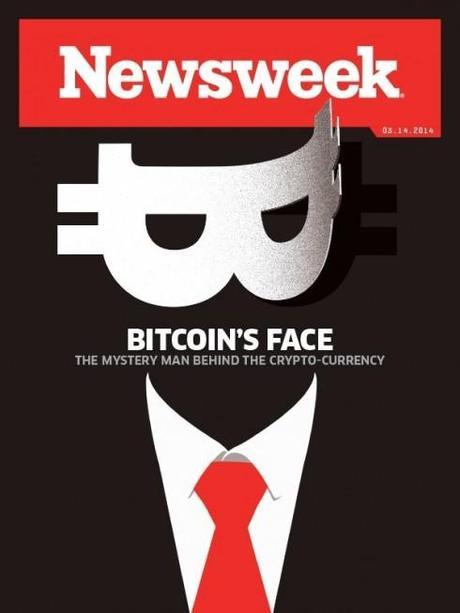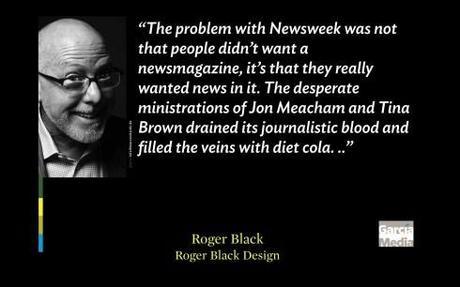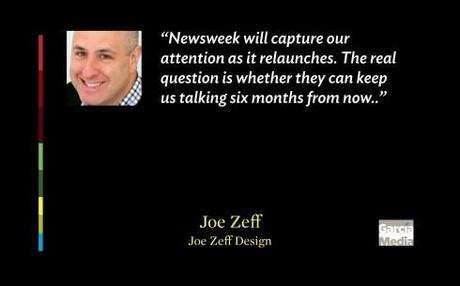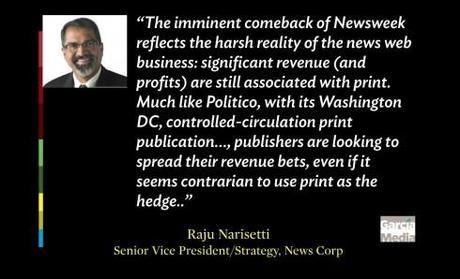TAKEAWAY: Today March 7 the printed edition of Newsweek magazine is launched. Our question: is there an audience for this? We talk to media experts Roger Black, Joe Zeff and Raju Narisetti to get their views.


It’s a familiar story: Newsweek not reporting the headlines but making the headlines.
It’s back today March 7.
In the continuing saga of the iconic magazine, with all the ups and downs of now it’s here, not it’s not, today’s chapter is a happy one: Newsweek returns. Remember that it published its famously heralded “last issue” exactly 14 months ago?
“Small is the new big,” writes Joe Pompeo for Politico. The 81-year-old publication returns as a boutique product complementing a digital-first strategy.
One wonders what research has gone into this relaunch? Is there evidence that some readers across the States are willing to read Newsweek in its printed edition, versus on their mini iPads, for example?
And how about advertisers?
We have spoken to three media experts—Roger Black, Joe Zeff, and Raju Narisetti—whose insights are below.
Experts on the return of a printed Newsweek

Roger Black’s association with Newsweek extends through the years. Here is his extended reaction to the news that a printed version of Newsweek will reappear in print today:
“The news that Newsweek is coming back—in print—gave me a little twinge. Having worked there for two years in the 80s, and helping later to redesign it at least three times, I have some vestigial loyalty to the old brand. Much of that was wiped out after the last time the Washington Post company hired me and then rejected my idea of turning the magazine into a weekly “monthly.” That is, a feature magazine, but one with actual reporting.
“This, it seems, is what the IBT people have in mind They may get to prove the idea, since the real problem the Post had with the title was a $40 million subscription liability. So they sold to Sid Harmon who let Tina Brown hold it under the water until all the little bubbles came out.
“It will be interesting to see if the new Newsweek gives a design nod to the old one. Tina had scraped all the chromosomes out of the visual DNA before the magazine closed, and I wonder if the new owner will think it’s worth it to restore some of it.
“They, should of course. Publishers tend to forget that when the sell their products. The loyal readers become the real owners, and they’re not happy when the manufacturer tampers with the design. The new Chinese owners of the Saab automobile brand grasped this. They’re now producing a 9-3 Aero that looks exactly like … a Saab. http://online.wsj.com/news/articles/SB10001424052702303670804579233763915726796
“The problem with Newsweek was not that people didn’t want a newsmagazine, it’s that they really wanted news in it. The desperate ministrations of Jon Meacham and Tina Brown drained its journalistic blood and filled the veins with diet cola.
* * *
“The blogging class widely assumes that the print model is dead, that people don’t want conventional magazines any more. It’s not the print model that is dead, it’s the print business model. If you create an absorbing, original publication, people are happy to hold it in their hands. While Newsweek was dying, The Economist was flourishing. That publication will never reach a three-million US paid circulation like Newsweek had when I worked there—they don’t want to—but they are making a profit and putting out a great magazine.
“Maybe some day we’ll make digital publications that can immerse you in stories the way print can, (I’m still waiting to see a photo layout on a tablet that’s not just a slide show.) Until then I believe readers will be happy to pay for the right magazine.
“Hell, I think that you could even bring back Life magazine, grown from fossilized visual DNA. There are enough people in the world who would pay at least the price of a MacDonald’s dinner for two to get timely photo storytelling from the Ukraine, Venezuela, Thailand, Turkey. I mean, I don’t see the documentary footage on TV anymore, just talking heads. And if a new threw in a few cat pictures, and babes of both sexes, then I bet you could make a good business with paid subs, newsstand, advertising and lively digital editions.
“So, I’m curious to see if the Newsweek has any of the old genetic material. I’m not saying it will fail if it doesn’t. But if they don’t summon up the great old ghost (and the Jim Parkinson logo), then what did they buy the name for?”
Joe Zeff is familiar with the war of the newsmagazines, as he was working with TIME Magazine at a time when it competed on a weekly basis with Newsweek. It was a matter of asking a good question each week: What will they have on their cover? Will their cover be better than ours?
After Newsweek died, the world kept on spinning. There was no gaping hole in the national conversation, just a bare slot at the newsstand that was quickly filled by something else. The magazine lost its way years earlier, starting with a soul-sapping redesign in 2009 that stripped away photography and infographics and replaced them with walls of words. Its circulation plummeted, along with its dignity. Tina Brown exhumed a photoshopped princess for an infamous Diana at 50cover that heralded the beginning of the end. Despite all that, the Newsweek brand still means something. In the 77 years that preceded its sale by The Washington Post, Newsweek won credibility for its relentless reportage and razor-sharp analysis. Working at TIME in the late 1990s, I had the privilege of going toe-to-toe with Lynn Staley and Karl Gude and the other outstanding journalists at Newsweek week after week. After leaving TIME, I was fortunate to work with the late Amid Capeci, Bruce Ramsay and others to illustrate quite a few Newsweek covers, each of them points of professional pride. The current ownership has assembled an impressive team: magazine designers Priest and Grace are as good as they come; Editor Jim Impoco did an amazing job with the late Conde Nast Portfolio magazine; and I’m a big fan of former NYT colleague Kurt Eichenwald. I wish them luck as they reintroduce Newsweek magazine to a world that has learned to get by without it. Just as TIME frequently reminds us of its relevance with a buzzworthy cover, Newsweek will capture our attention as it relaunches. The real question is whether they can keep us talking six months from now.
And, in what may appear to be a continuation of the eternal war between Newsweek and TIME, it is rumored that TIME may unveil its much awaited redesign this week as well. We are looking forward to that as well.
From Raju Narisetti, News Corp’s Senior Vice President/Strategy:
“The imminent comeback of Newsweek reflects the harsh reality of the news web business: significant revenue (and profits) are still associated with print. Much like Politico, with its Washington DC, controlled-circulation print publication, and with their newly purchased, Capital NY’s recent print publication, publishers are looking to spread their revenue bets, even if it seems contrarian to use print as the hedge. As in, when an advertising “falls” in the global digital jungle, it doesn’t really make a noise for the client.
Newsweek’s new publishers probably also realized the brand has some resonance and print legs in a few non-US markets, again allowing them to potentially target more lucrative, regional and global print advertisers that perhaps wasn’t fully realized in a US-centric sales approach. I also fully expect Newsweek.com to unveil a paywall that will bundle print and online, to make the offering more palatable. But the economics of print, where reputed weekly publications try to acquire multi-year subscribers—2 years (100 issues) of Business Week for $50 or 12 issues of Washingtonian for $12, and likely re-invigorated competition from Time Inc will mean that the old Newsweek’s Pepsi to Time magazine’s Coke strategy will need to be very well executed and tightly controlled in the print space. I wish Jim Impoco and his editorial team the best of luck in getting the 81-year-old to (re)live up to 100, for starters.”
Of related iinterest
Newsweek to Restart Printing Presses
Highlight:
The Graham family, longtime newspaper publishers, gave up and sold it for a dollar. The media mogul Barry Diller spent tens of millions trying to revive it, only to throw in the towel. Even Mr. Diller’s star editor, Tina Brown, could not stop it from going out of print.
But where giants failed, IBT Media, a small digital publishing company, sees a growth path for Newsweek, the struggling newsweekly magazine it bought for a pittance last summer.
The newsonomics of Newsweek’s pricey relaunch
http://www.niemanlab.org/2014/03/the-newsonomics-of-newsweeks-pricey-relaunch/?utm_source=API%27s+Need+to+Know+newsletter&utm_campaign=da69987d79-Need_to_Know_March_5_20143_5_2014&utm_medium=email&utm_term=0_e3bf78af04-da69987d79-31701869
TheMarioBlog post # 1448




posted on 07 March at 06:04
Newsweek, new print, new image. Good luck.